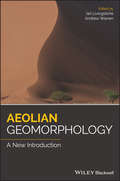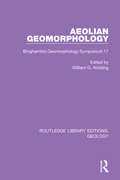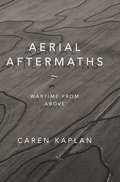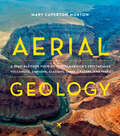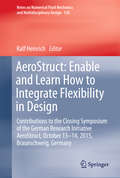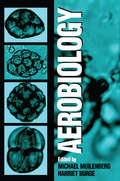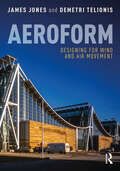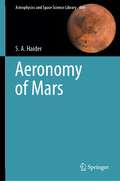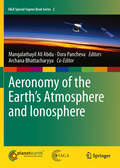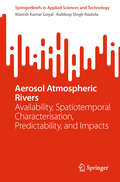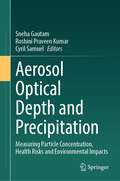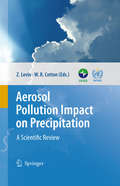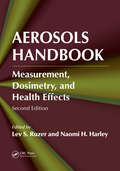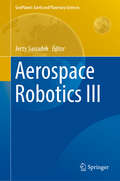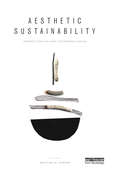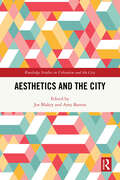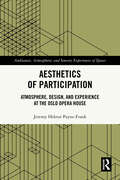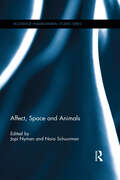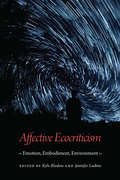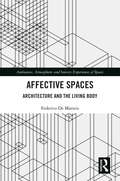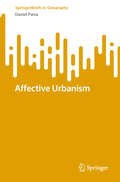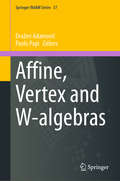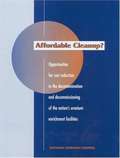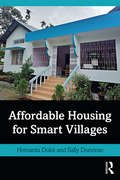- Table View
- List View
Aeolian Geomorphology: A New Introduction (Zeitschrift Für Geomorphologie, Supplementbände Ser.)
by Ian Livingstone Andrew WarrenA revised introduction to aeolian geomorphology written by noted experts in the field The new, revised and updated edition of Aeolian Geomorphology offers a concise and highly accessible introduction to the subject. The text covers the topics of deserts and coastlines, as well as periglacial and planetary landforms. The authors review the range of aeolian characteristics that include soil erosion and its consequences, continental scale dust storms, sand dunes and loess. Aeolian Geomorphology explores the importance of aeolian processes in the past, and the application of knowledge about aeolian geomorphology in environmental management. The new edition includes contributions from eighteen experts from four continents. All the chapters demonstrate huge advances in observation, measurement and mathematical modelling. For example, the chapter on sand seas shows the impact of greatly enhanced and accessible remote sensing and the chapter on active dunes clearly demonstrates the impact of improvements in field techniques. Other examples reveal the power of greatly improved laboratory techniques. This important text: Offers a comprehensive review of aeolian geomorphology Contains contributions from an international panel of eighteen experts in the field Includes the results of the most recent research on the topic Filled with illustrative examples that demonstrate the advances in laboratory approaches Written for students and professionals in the field, Aeolian Geomorphology provides a comprehensive introduction to the topic in twelve new chapters with contributions from noted experts in the field.
Aeolian Geomorphology: Binghamton Geomorphology Symposium 17 (Routledge Library Editions: Geology #2)
by William G. NicklingThis book, first published in 1986, stems from the 1986 Binghamton Geomorphology Symposium. The topic was chosen because of the advances in the study of aeolian processes and landforms, particularly in the area of desertification, and the papers collected here clearly indicate that their study is not constrained by discipline boundaries but are of interest to geologists, physical geographers, soil scientists, meteorologists and engineers.
Aerial Aftermaths: Wartime from Above
by Caren KaplanFrom the first vistas provided by flight in balloons in the eighteenth century to the most recent sensing operations performed by military drones, the history of aerial imagery has marked the transformation of how people perceived their world, better understood their past, and imagined their future. In Aerial Aftermaths Caren Kaplan traces this cultural history, showing how aerial views operate as a form of world-making tied to the times and places of war. Kaplan’s investigation of the aerial arts of war—painting, photography, and digital imaging—range from England's surveys of Scotland following the defeat of the 1746 Jacobite rebellion and early twentieth-century photographic mapping of Iraq to images taken in the immediate aftermath of 9/11. Throughout, Kaplan foregrounds aerial imagery's importance to modern visual culture and its ability to enforce colonial power, demonstrating both the destructive force and the potential for political connection that come with viewing from above.
Aerial Geology: A High-Altitude Tour of North America’s Spectacular Volcanoes, Canyons, Glaciers, Lakes, Craters, and Peaks
by Mary Caperton Morton“Get your head into the clouds with Aerial Geology.” —The New York Times Book ReviewAerial Geology is an up-in-the-sky exploration of North America’s 100 most spectacular geological formations. Crisscrossing the continent from the Aleutian Islands in Alaska to the Great Salt Lake in Utah and to the Chicxulub Crater in Mexico, Mary Caperton Morton brings you on a fantastic tour, sharing aerial and satellite photography, explanations on how each site was formed, and details on what makes each landform noteworthy. Maps and diagrams help illustrate the geological processes and clarify scientific concepts. Fact-filled, curious, and way more fun than the geology you remember from grade school, Aerial Geology is a must-have for the insatiably curious, armchair geologists, million-mile travelers, and anyone who has stared out the window of a plane and wondered what was below.
AeroStruct: Contributions to the Closing Symposium of the German Research Initiative AeroStruct, October 13–14, 2015, Braunschweig, Germany (Notes on Numerical Fluid Mechanics and Multidisciplinary Design #138)
by Ralf HeinrichThis book reports on the German research initiative AeroStruct, a three-year collaborative project between universities and the aircraft industry. It describes the development of an integrated multidisciplinary simulation environment for aircraft analysis and optimization using high-fidelity methods. This system is able to run at a high level of automatism, thus representing a step forward with respect to previous ones. Its special features are: a CAD description that is independent from the disciplines involved, an automated CFD mesh generation and an automated structure model generation including a sizing process. The book also reports on test cases by both industrial partners and DLR demonstrating the advantages of the new environment and its suitability for the industry. These results were also discussed during the AeroStruct closing Symposium, which took place on 13-14 October 2015 at the DLR in Braunschweig, Germany. The book provides expert readers with a timely report on multidisciplinary aircraft design and optimization. Thanks to a good balance between theory and practice, it is expected to address an audience of both academics and professional, and to offer them new ideas for future research and development.
Aerobiology
by Michael L. Muilenberg Harriet A. BurgeAerobiology is the study of airborne particles that have an impact on humans and other organisms. Every day, we are exposed to airborne particles, including "natural" particles such as pollen, bacteria, and fungi, and "unnatural" particles, such as asbestos fibers and noxious chemicals. Aerobiology highlights the current interests in this field, primarily the ecology and distribution of airborne particles and their effects on health.
Aeroform: Designing for Wind and Air Movement
by James Jones Demetri TelionisAeroform: Designing for Wind and Air Movement provides a comprehensive introduction to applying aerodynamic principles to architectural design. It presents a challenge to architects and architectural engineers to give shape to the wind and express its influence on architectural form. The wind pushes and pulls on our buildings, infiltrates and exfiltrates through cracks and openings, and lifts roofs during storm events. It can also offer opportunities for resource conservation through natural ventilation or a biophilic connection between indoors and out. This book provides basic concepts in fluid mechanics such as materials, forces, equilibrium, pressure, and hydrostatics; introduces the reader to the concept of airflow; and provides strategies for designing for wind resistance, especially in preventing uplift. Natural ventilation and forced airflow are explored using examples such as Thomas Herzog’s Hall 26 in Hanover, RWE Ag building in Essen Germany, and the Kimbell Art Museum in Texas. Finally, issues of wind and airflow measurement are addressed. A reference for students and practitioners of architecture and architectural engineering, this book is richly illustrated and presents complex concepts of aerodynamic engineering in easy-to-understand language. It prepares the architect or architectural engineer to design buildings that are visually expressive of a dialogue between wind and built form.
Aeronomy of Mars (Astrophysics and Space Science Library #469)
by S. A. Haider“Mangalyaan was launched on November 5, 2013, to Mars by Indian Space Research Organization (ISRO). On October 2, 2022, ISRO declared that Mangalyaan had lost communications with Earth. Mars Color Camera (MCC) on-board Mangalyaan has taken thousands pictures of Mars. A full disk of Mars image observed by Viking is shown on the cover page of this book. Mars is covered by the dust as observed by Mangalyaan (from Arya et al., 2015). This book presents the atmospheric and ionospheric results obtained from all missions to Mars. It also covers various atmospheric and ionospheric models of Mars. Broadly speaking, the planet’s atmosphere can be divided into two regions: lower and upper. These two regions can be coupled due to the propagation of energy from the lower to the upper atmosphere. The first-ever book on the aeronomy of Mars, this work is intended to help students and researchers familiarize themselves with the field of aeronomy. In addition, it helps planetary probe designers, engineers, and other users in the scientific community, e.g., planetary geologists and geophysicists”.
Aeronomy of the Earth's Atmosphere and Ionosphere (IAGA Special Sopron Book Series #2)
by Archana Bhattacharyya Dora Pancheva Mangalathayil Ali AbduThis book is a multi-author treatise on the most outstanding research problems in the field of the aeronomy of the Earth's atmosphere and ionosphere, encompassing the science covered by Division II of the International Association of Geomagnetism and Aeronomy (IAGA). It contains several review articles and detailed papers by leading scientists in the field. The book is organized in five parts: 1) Mesosphere-Lower Thermosphere Dynamics and Chemistry; 2) Vertical Coupling by Upward Propagating Waves; 3) Ionospheric Electrodynamics and Structuring; 4) Thermosphere- Ionosphere Coupling, Dynamics and Trends and 5) Ionosphere-Thermosphere Disturbances and Modeling. The book consolidates the progress achieved in the field in recent years and it serves as a useful reference for graduate students as well as experienced researchers.
Aerosol Atmospheric Rivers: Availability, Spatiotemporal Characterisation, Predictability, and Impacts (SpringerBriefs in Applied Sciences and Technology)
by Manish Kumar Goyal Kuldeep Singh RautelaThis book thoroughly examines aerosol pollution and aerosol atmospheric rivers (narrow corridors of concentrated suspended aerosols in the sky), exploring their significant effects on human health, the environment, and global climate. Readers will find detailed discussions on these phenomena' sources, composition, patterns, and advanced methods for their detection, monitoring, and mitigation. Each chapter examines the complex dynamics of aerosol atmospheric rivers and the use of data mining and artificial intelligence in analyzing aerosol pollution. The book also highlights the interactions between aerosol pollution, aerosol atmospheric rivers, and particulate matter concentrations with associated risk, offering practical adaptation, mitigation, and resilience strategies.
Aerosol Optical Depth and Precipitation: Measuring Particle Concentration, Health Risks and Environmental Impacts
by Sneha Gautam Cyril Samuel Roshini Praveen KumarThis volume uses aerosol optical depth (AOD) analysis through mapping and remote sensing techniques to derive the relationship between aerosols and hazardous precipitation events, primarily in the form of flooding. Attention is also given to pollution caused by an abundance of particulate matter in the atmosphere and its impacts on human health, which is also assessed via the study of AOD. Background is given on how AOD is retrieved, and why it is a useful tool for estimating atmospheric particle concentration, but also the challenges associated with using this approach. Different aerosol types are introduced to perform a comparative analysis of the most common associations between pollution impacts on temperature and resulting precipitation events. These analyses will help to provide an overview of the best strategies to make informed and sustainable disaster risk management practices and policies. The target audience for the work is students, researchers, and scientists working witha vision towards sustainability, public health safety and air pollution mitigation measures. It will also be a useful text for climate change policy makers, environmental engineers and stakeholders in social development sectors.
Aerosol Pollution Impact on Precipitation: A Scientific Review
by Zev Levin William R. CottonLife on Earth is critically dependent upon the continuous cycling of water between oceans, continents and the atmosphere. Precipitation (including rain, snow, and hail) is the primary mechanism for transporting water from the atmosphere back to the Earth's surface. It is also the key physical process that links aspects of climate, weather, and the global hydrological cycle. Changes in precipitation regimes and the frequency of extreme weather events, such as floods, droughts, severe ice/snow storms, monsoon fluctuations and hurricanes are of great potential importance to life on the planet. One of the factors that could contribute to precipitation modification is aerosol pollution from various sources such as urban air pollution and biomass burning. Natural and anthropogenic changes in atmospheric aerosols might have important implications for precipitation by influencing the hydrological cycle, which in turn could feed back to climate changes. From an Earth Science perspective, a key question is how changes expected in climate will translate into changes in the hydrological cycle, and what trends may be expected in the future. We require a much better understanding and hence predictive capability of the moisture and energy storages and exchanges among the Earth's atmosphere, oceans, continents and biological systems. This book is a review of our knowledge of the relationship between aerosols and precipitation reaching the Earth's surface and it includes a list of recommendations that could help to advance our knowledge in this area.
Aerosols Handbook: Measurement, Dosimetry, and Health Effects, Second Edition
by Lev S. Ruzer Naomi H. HarleyWith the rapid growth of the nanotechnology industry, the need to understand the biological effects of aerosol exposure has become increasingly important. Featuring contributions by leading experts in the field, Aerosols Handbook: Measurement, Dosimetry, and Health Effects, Second Edition offers an up-to-date overview of many aspects of aerosols, f
Aerospace Robotics III (GeoPlanet: Earth and Planetary Sciences)
by Jerzy SasiadekThis book includes extended versions of original works on aerospace robotics presented at the Conference on Aerospace Robotics (CARO) in Warsaw. It presents recent advances in aerospace robotics, such as manipulators, which are widely used in space for orbital operations, for example, the Mobile Servicing System on the International Space Station and the Shuttle Remote Manipulator System. Such manipulators are operated by astronauts and mounted on large platforms, making the influence of manipulator motion on the state of the platform insignificant. Application of manipulators for capture maneuvers in unmanned On-Orbit Servicing or Active Debris Removal missions requires reliable control algorithms that take into account the free-floating nature of the manipulator-equipped spacecraft. As such the book presents possibilities for using space manipulators for exploration and a variety of space operations. Further, it discusses new methods for the control of autonomous unmanned aerial vehicles (UAV) using vision systems and sensor fusion methodologies. Such autonomous flying vehicles could be used for materials deliveries and emergencies, as well as surveying and servicing.
Aerospace Robotics: Selected Papers from I Conference on Robotics in Aeronautics and Astronautics (GeoPlanet: Earth and Planetary Sciences)
by Jerzy SąsiadekThis book presents the most important and crucial problems of space automation in context of future exploration programs. These programs could involve such issues as space situational awareness program, planetary protection, exploitation of minerals, assembly, manufacturing, and search for new habitable location for next human generations. The future exploration of Space and related activities will involve robots. In particular, new autonomous robots need to be developed with high degree of intelligence. Such robots would make space exploration possible but also they would make space automation an important factor in variety of activities related to Space.
Aesthetic Sustainability: Product Design and Sustainable Usage (Routledge Studies in Sustainability)
by Kristine H. HarperWhy do we readily dispose of some things, whereas we keep and maintain others for years, despite their obvious wear and tear? Can a greater understanding of aesthetic value lead to a more strategic and sustainable approach to product design? Aesthetic Sustainability: Product Design and Sustainable Usage offers guidelines for ways to reduce, rethink, and reform consumption. Its focus on aesthetics adds a new dimension to the creation, as well as the consumption, of sustainable products. The chapters offer innovative ways of working with expressional durability in the design process. Aesthetic Sustainability: Product Design and Sustainable Usage is related to emotional durability in the sense that the focus is on the psychological and sensuous bond between subject and object. But the subject–object connection is based on more than emotions: aesthetically sustainable objects continuously add nourishment to human life. This book explores the difference between sentimental value and aesthetic value, and it offers suggestions for operational approaches that can be implemented in the design process to increase aesthetic sustainability. This book also offers a thorough presentation of aesthetics, focusing on the correlation between the philosophical approach to the aesthetic experience and the durable design experience. The book is of interest to students and scholars working in the fields of design, arts, the humanities and social sciences; additionally, it will speak to designers and other professionals with an interest in sustainability and aesthetic value.
Aesthetics and the City (Routledge Studies in Urbanism and the City)
by Joe Blakey Amy BarronAesthetics and the City engages aesthetics to explore the role of the city in urban experience. Drawing on diverse theories and global case studies, this edited collection examines how aesthetics relates to how cities and urban spaces are perceived, organised, and transformed.This book celebrates and ponders the wide diversity of aesthetic approaches within urban studies, noting that the way aesthetics is understood impacts what can be understood about cities and the urban order more generally. In its most general sense, aesthetics refers to our sensuous relation to the world. It invariably figures in how we make sense of the city and ourselves—bound to how urban life is experienced imaginatively, materially, socially, culturally, and politically. In an era where scholars have expressed concern at epistemological city-centrism, aesthetics is proposed as a versatile concept through which the centrality of the city to urban thought can be assessed. The book also explores how aesthetics intersects with a range of tangential concepts including power, the political, art, and affect. Ultimately it makes the case that this diverse ensemble of approaches to aesthetics can enable scholars to understand the city and its enduring relevance to urban thought.This book focuses on the concepts of "aesthetics" and "the city" and will appeal to scholars and students in urban studies, human geography, planning, politics, and sociology.
Aesthetics of Participation: Atmosphere, Design, and Experience at the Oslo Opera House (Ambiances, Atmospheres and Sensory Experiences of Spaces)
by Jeremy Hektor Payne-FrankThis book explores the way people participate with the Oslo Opera House, Norway. As an iconic and culture-led building, these different modes of participation reveal the tensions between staged space and individual experience.Movement, materiality, light, and art are viewed through an atmospheric lens to demonstrate how architecture can shape people’s engagement with, and understanding of, urban space. This book contributes to a growing literatureon atmosphere in relation to our experience of the built environment. In adopting this atmospheric perspective, the book speaks to the concerns of designers, users, and researchers interested in the way contemporary development infuses our cities with the experiential, as a means of developing access, participation, and democracy. It explores the ways in which people experience a building, held up against the claims, intentions, and assumptions that surround it. The book’s focus on design, participation, and experience, in relation to political ideals, will appeal to architects, planners, and academics concerned with the production of space. Equally, its underlying atmospheric contribution and methodological approach will be of interest to designers, scholars, professionals, and students of ambiance, affect and atmosphere, architecture, city planners and urban developers, human geographies, anthropology, and urban studies.
Affect, Space and Animals (Routledge Human-Animal Studies Series)
by Jopi Nyman Nora SchuurmanIn recent years, animals have entered the focus of the social and cultural sciences, resulting in the emergence of the new field of human-animal studies. This book investigates the relationships between humans and animals, paying particular attention to the role of affect, space, and animal subjectivity in diverse human-animal encounters. Written by a team of international scholars, contributions explore current debates concerning animal representation, performativity, and relationality in various texts and practices. Part I explores how animals are framed as affective, through four case studies that deal with climate change, human-bovine relationships, and human-horse interaction in different contemporary and historical contexts. Part II expands on the issue of relationality and locates encounters within place, mapping the different spaces where human-animal encounters take place. Part III then examines the construction of animal subjectivity and agency to emphasize the way in which animals are conscious and sentient beings capable of experiencing feelings, emotions, and intentions, and active agents whose actions have meaning for the animals themselves. This book highlights the importance of the ways in which affect enables animal agency and subjectivity to emerge in encounters between humans and animals in different contexts, leading to different configurations. It contributes not only to debates concerning the role of animals in society but also to the epistemological development of the field of human-animal studies.
Affective Ecocriticism: Emotion, Embodiment, Environment
by Kyle Bladow Jennifer LadinoScholars of ecocriticism have long tried to articulate emotional relationships to environments. Only recently, however, have they begun to draw on the complex interdisciplinary body of research known as affect theory. Affective Ecocriticism takes as its premise that ecocritical scholarship has much to gain from the rich work on affect and emotion happening within social and cultural theory, geography, psychology, philosophy, queer theory, feminist theory, narratology, and neuroscience, among others. This vibrant and important volume imagines a more affective—and consequently more effective—ecocriticism, as well as a more environmentally attuned affect studies. These interdisciplinary essays model a range of approaches to emotion and affect in considering a variety of primary texts, including short story collections, films, poetry, curricular programs, and contentious geopolitical locales such as Canada’s Tar Sands. Several chapters deal skeptically with familiar environmentalist affects like love, hope, resilience, and optimism; others consider what are often understood as negative emotions, such as anxiety, disappointment, and homesickness—all with an eye toward reinvigorating or reconsidering their utility for the environmental humanities and environmentalism. Affective Ecocriticism offers an accessible approach to this theoretical intersection that will speak to readers across multiple disciplinary and geographic locations.
Affective Spaces: Architecture and the Living Body (Ambiances, Atmospheres and Sensory Experiences of Spaces)
by Federico De MatteisThis book explores the notion of affective space in relation to architecture. It helps to clarify the first-person, direct experience of the environment and how it impacts a person’s emotional states, influencing their perception of the world around them. Affective space has become a central notion in several discussions across philosophy, geography, anthropology, architecture and so on. However, only a limited selection of its key features finds resonance in architectural and urban theory, especially the idea of atmospheres, through the work of German phenomenologist Gernot Böhme. This book brings to light a wider range of issues bound to lived corporeal experience. These further issues have only received minor attention in architecture, where the discourse on affective space mostly remains superficial. The theory of atmospheres, in particular, is often criticized as being a surface-level, shallow theory as it is introduced in an unsystematic and fragmented fashion, and is a mere "easy to use" segment of what is a wider and all but impressionistic analytical method. This book provides a broader outlook on the topic and creates an entry point into a hitherto underexplored field. The book’s theoretical foundation rests on a wide range of non-architectural sources, primarily from philosophy, anthropology and the cognitive sciences, and is strengthened through cases drawn from actual architectural and urban space. These cases make the book more comprehensible for readers not versed in contemporary philosophical trends.
Affective Urbanism (SpringerBriefs in Geography)
by Daniel PaivaThe book poses key questions on the contemporary practices of experience-oriented urbanism from the perspective of the affective turn. Departing from a critique of the imposition of the experience economy on contemporary urbanism, the book seeks alternative narratives and praxis for the co-creation of experiences in the city by looking at how different urban curators play with rhythms, atmospheres, and worlds to improve their communities. In this sense, the book offers practical pathways for urbanists interested in using experience co-creation as a tool for fostering communities and fulfilling the right to the city. The book is mainly targeted to researchers, postgraduate students, and practitioners. The topic of affective urbanism is of interest to scholars in urban studies, architecture, geography, anthropology, and sociology.
Affine, Vertex and W-algebras (Springer INdAM Series #37)
by Paolo Papi Dražen AdamovićThis book focuses on recent developments in the theory of vertex algebras, with particular emphasis on affine vertex algebras, affine W-algebras, and W-algebras appearing in physical theories such as logarithmic conformal field theory. It is widely accepted in the mathematical community that the best way to study the representation theory of affine Kac–Moody algebras is by investigating the representation theory of the associated affine vertex and W-algebras. In this volume, this general idea can be seen at work from several points of view. Most relevant state of the art topics are covered, including fusion, relationships with finite dimensional Lie theory, permutation orbifolds, higher Zhu algebras, connections with combinatorics, and mathematical physics. The volume is based on the INdAM Workshop Affine, Vertex and W-algebras, held in Rome from 11 to 15 December 2017. It will be of interest to all researchers in the field.
Affordable Cleanup?: Opportunities for cost reduction in the decontamination and decommissioning of the nation's uranium enrichment facilities
by Committee on Decontamination Decommissioning of Uranium Enrichment FacilitiesThe Energy Policy Act of 1992 called on the National Academy of Sciences to conduct a study and provide recommendations for reducing the costs of decontaminating and decommissioning (D&D) the nation's uranium enrichment facilities located at Oak Ridge, Tennessee; Raducah, Kentucky; and Portsmouth, Ohio. This volume examines the existing plans and cost estimates for the D&D of these facilities, including such elements as technologies, planning and management, and identifies approaches that could reduce D&D costs. It also assesses options for disposition of the large quantities of depleted uranium hexafluoride that are stored at these sites.
Affordable Housing for Smart Villages
by Sally Donovan Hemanta DoloiThis book initiates a fresh discussion of affordability in rural housing set in the context of the rapidly shifting balance between rural and urban populations. It conceptualises affordability in rural housing along a spectrum that is interlaced with cultural and social values integral to rural livelihoods at both personal and community level. Developed around four intersecting themes: explaining houses and housing in rural settings; exploring affordability in the context of aspirations and vulnerability; rural development agendas involving housing and communities; and construction for resilience in rural communities, the book provides an overview of some of the little understood and sometimes counter-intuitive best practices on rural affordability and affordable housing that have emerged in developing economies over the last thirty years. Drawing on practice-based evidence this book presents innovative ideas for harnessing rural potential, and empowering rural communities with added affordability and progressive development in the context of housing and improved living standards. For a student aspiring to work in rural areas in developing countries it is an introduction to and map of some key solutions around the critical area of affordable housing For the rural development professional, it provides a map of a territory they rarely see because they are absorbed in a particular rural area or project For the academic looking to expand their activities into rural areas, especially in rural housing, it provides a handy introduction to a body of knowledge serving 47% of the world's population, and how this differs from urban practice For the policy makers, it provides a map for understanding the dynamics around rural affordability, growth potential and community aspirations helping them to devise appropriate intervention programs on rural housing and development
